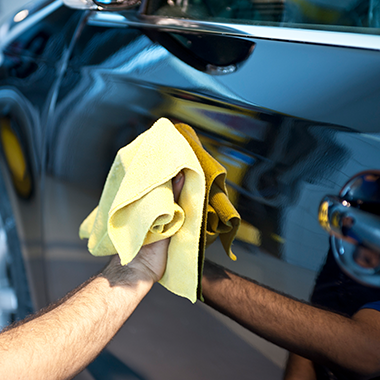Car interior cleaning

Cleaning the interior of a car is a task that many drivers avoid. However, traveling in a well-maintained, clean, and pleasantly scented car is much more enjoyable and even contributes to driving safety. Thoroughly cleaning a car requires time, but with a bit of practice, it can be done quickly and thoroughly. The key is to use appropriate cleaning accessories and products based on the type of surface and dirt. Household dishwashing products or other aggressive liquids could damage plastic, wood, or leather components. It's also essential to start the interior care process correctly to avoid soiling previously cleaned surfaces. Professional car interior cleaning can transform even the most neglected car to look almost new.
Tips
Start cleaning your car by vacuuming the interior. It's best to remove floor mats and slide the seats to reach every nook and cranny. Use a crevice tool to remove dust and dirt from the seat crevices. To effectively vacuum the upholstered floor, a powerful vacuum cleaner is necessary, as handheld ones powered by the car's socket might not remove deeply embedded debris.
Continue the cleaning process from "top to bottom," and thoroughly clean the windows. Home remedies may work, but it's best to use dedicated car window cleaning solutions commonly used in auto detailing. These solutions are safe for seals and plastic elements and often come with anti-fogging additives.
Avoid using popular spray-on products for cleaning plastics, as they leave a sticky layer that attracts dust. Professional detailing studios start by cleaning plastic surfaces with a microfiber cloth and an all-purpose cleaner (APC), followed by applying dressing. Dressing nourishes and darkens the plastic elements while protecting them from dust settling.
For regular interior maintenance, ready-to-use universal detergents, known as interior cleaners, are sufficient. They work well for cleaning plastics, upholstery, and car windows. Unlike APC, they don't require dilution or rinsing with water.
Additional cleaning accessories will be helpful for thorough cleaning. Brushes can be used to clean rough plastic surfaces, and detailing brushes and sponges can reach areas difficult to access with regular cloths. A soft brush can clean ventilation grilles, seals, buttons, or glove box hinges.
High-gloss lacquered elements like "piano black" may require polishing, similar to the process used on the car's body or rims. Removing scratches from these surfaces is easier than polishing scratches on the car's body, but it requires skill.
Steam cleaning can be used for hinges, door recesses, pedals, and other places with tough dirt.
When caring for elements like the steering wheel, use dedicated car cosmetics exclusively. Household cleaning agents could damage the clear protective layer (topcoat) and saturate the leather.
Not all elements can be cleaned mechanically, which is why ozone treatment is an excellent idea. An ozone generator eliminates mold, bacteria, fungi, viruses, and unpleasant odors, such as cigarette smoke or musty smell. During ozone treatment, close the car's doors and windows, and ensure there are no people, animals, or plants inside the vehicle.
Scope of services
Vacuuming the car interior
Thorough cleaning of plastic elements
Cleaning car windows
Eliminating unpleasant odors from the passenger cabin
Ozone treatment of the car interior
Cleaning hard-to-reach areas
Caring for the steering wheel and other leather elements
Protecting plastics with antistatic agents
Refreshing the lacquer coating on dashboard elements
Safely cleaning the upholstered headliner
Extraction cleaning of the upholstery
Find a car workshop
Check out our workshops that offer the service car interior cleaning in some of the biggest cities in your country
Additional info about the service
Using professional car cleaning products makes the cleaning process enjoyable and, most importantly, effective. Cleaning a car with household cleaning products often leads to frustration, as these products may not effectively remove car-specific contaminants. Moreover, aggressive chemicals can permanently damage many materials found in cars. Strong cleaning agents can destroy the protective layer on leather upholstery, erase markings on buttons, peel off rubber trim on dashboard elements, or cause the headliner to detach. To avoid such damages, one needs to know how and what to clean each component.
The cost of cleaning car upholstery
If you want to safely clean the upholstery, remove difficult stains, or thoroughly wash the passenger cabin, it's best to rely on professionals. The cost of a thorough car interior cleaning service in a detailing studio or car wash ranges from approximately $250 to $1000, depending on the vehicle's size and the amount of work required. Handwashing your car is, of course, cheaper, but remember that buying the necessary cleaning products and accessories can also add up to a considerable expense.